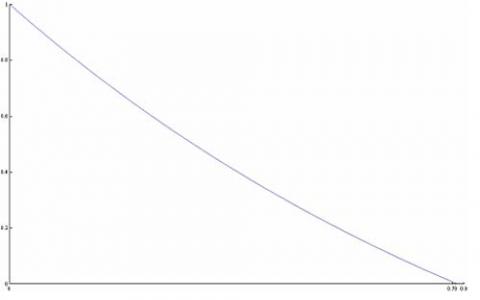Equation attack
The equation a^x + b^x = 1 can be solved algebraically in special cases but in general it can only be solved by numerical methods.
Problem
Solve the equation $$a^x + b^x = 1$$ where $0< a, b < 1$ and $a + b < 1$, in the special cases:
(i) $a = b\quad $ (ii) $a = {1\over 2}, \ b={1\over 4}\quad $ (iii) $a = {1\over 2}, \ b={1\over 3}$ .
Although you can find exact solutions in special cases like (i) and (ii) it soon becomes apparent that generally you will need to use a numerical method for finding approximate solutions.
Getting Started
Let $f(x) = a^x + b^x - 1$, find $f(0)$ and $f(1)$ and consider the graph of $f(x)$.
Student Solutions
Well done Rhema from Crown Woods School, Simon from Elizabeth College, Guernsey,Trevor from Queen Elizabeth's School, Barnet and Andrei from Tudor Vianu National College, Bucharest, Romania, you all sent in good solutions. To find the solution as a numerical approximation, Andrei used interval halving and a graphical method, Trevor and Simon used the Newton-Raphson method, Trevor used a spreadsheet for the calculations and Simon wrote a program in C to do the calculations.
Case (i)
If $a = b$ the equation $a^x + b^x = 1$ where $0< a, b < 1$ and $a + b < 1$ becomes $2a^x =1 $. Then $\log 2 + x \log a = 0$ so the solution can be given in three equivalent forms: $$x = {-\log 2 \over \log a} = {\log 0.5 \over \log a } = {\log 2 \over \log 1/a}.$$ Note we can use natural logarithms here or logarithms to any base.
Case (ii)
Solve $a^x + b^x = 1$, where $a=1/2$ and $b=1/4$. The equation is: $$(1/2)^x + (1/4)^x = 1,$$ Here you could substitute $y = (1/2)^x$ but Trevor multiplied by $4^x$ and used the substitution $y = 2^x$. By Trevor's method: $$4^x/2^x + 1 = 4^x$$ So $$2^x + 1 = (2^x)^2.$$ and the equation becomes: $y + 1= y^2$ or $y^2- y- 1 = 0$. Using the quadratic formula, the negative solution to the quadratic can be ignored as $2^x$ is never negative, so the solution is: $$y={1+ \sqrt 5 \over 2}$$ (note this equals the golden ratio, $\phi $). Therefore $2^x = \phi$ and so $x\ln 2 = \ln \phi$ and the solution is: $$x= {\ln \phi \over \ln 2} ={ \ln (1 + \sqrt 5)/2 \over \ln 2}$$ giving $x = 0.69424$ to 5 significant figures
Case (iii)
This is Andrei's method using interval halving:
Here I observe that I cannot solve the equation directly. First I shall prove that for any $0 < a, b < 1$, with $a + b < 1$, the equation $a^x + b^x = 1$ has a unique solution. Let $f: [0,1] \to R, f(x) = a^x + b^x - 1$ then $$f(0) = 1 > 0, f(1) = a + b - 1 < 0$$ and $f$ is a continuous function, so $f(x) = 0$ has at least one solution in its interval of definition. I shall now prove it is unique. The derivative $$f'(x) = a^x \ln a + b^x \ln b < 0,$$ as $a$ and $b < 1$. So, $f$ is strictly decreasing and the solution is unique.
For the case of the problem, $a =1/2$ and $b = 1/3$ I cannot find the exact value of the root, but I can find a good approximation of the solution. I shall use the interval halving method. Let $x_0$ be the root. The first value that I choose is 1/2.
So, $0.7871 < x_0 < 0.7880$. Continuing the procedure, I could find a better approximation for the root $x_0$.
Image

| Another method, though less precise, would have been a graphical one. In this graph I have plotted f(x) and the solution is given by the intersection with the x-axis. |

Here is Trevor's spreadsheet for this calculation.
Teachers' Resources
When you meet a class of equations like this it would be good to find a general formula involving $a$ and $b$ (like the formula for solutions of quadratic equations).
It often helps towards a general solution to try special cases as suggested in this problem and exact solutions can be found in special cases. More generally however there is no closed formula for solutions and you will need to find approximate solutions by numerical methods.
This problem involves the use of logs, solving a quadratic equation and using a numerical method such as interval halving or the Newton Raphson method. To speed up the process of solving this equation for a particular pair of values of $a$ and $b$ you can use a programmable calculator or a spreadsheet.
